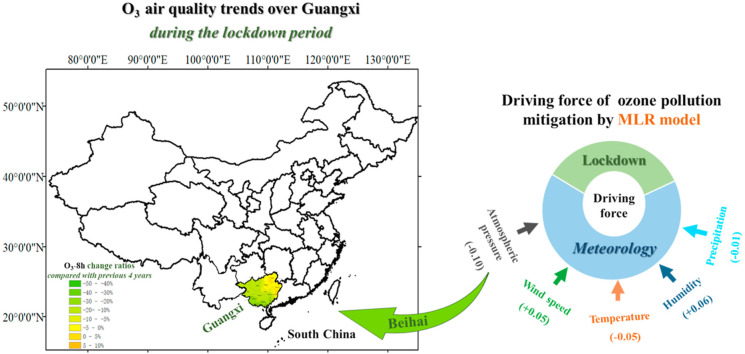- Record: found
- Abstract: found
- Article: not found
Ozone pollution mitigation in Guangxi (South China) driven by meteorology and anthropogenic emissions during the COVID-19 lockdown ☆

Read this article at
Abstract
With the implementation of COVID-19 restrictions and consequent improvement in air quality due to the nationwide lockdown, ozone (O 3) pollution was generally amplified in China. However, the O 3 levels throughout the Guangxi region of South China showed a clear downward trend during the lockdown. To better understand this unusual phenomenon, we investigated the characteristics of conventional pollutants, the influence of meteorological and anthropogenic factors quantified by a multiple linear regression (MLR) model, and the impact of local sources and long-range transport based on a continuous emission monitoring system (CEMS) and the HYSPLIT model. Results show that in Guangxi, the conventional pollutants generally declined during the COVID-19 lockdown period (January 24 to February 9, 2020) compared with their concentrations during 2016–2019, while O 3 gradually increased during the resumption (10 February to April 2020) and full operation periods (May and June 2020). Focusing on Beihai, a typical Guangxi region city, the correlations between the daily O 3 concentrations and six meteorological parameters (wind speed, visibility, temperature, humidity, precipitation, and atmospheric pressure) and their corresponding regression coefficients indicate that meteorological conditions were generally conducive to O 3 pollution mitigation during the lockdown. A 7.84 μg/m 3 drop in O 3 concentration was driven by meteorology, with other decreases (4.11 μg/m 3) explained by reduced anthropogenic emissions of O 3 precursors. Taken together, the lower NO 2/SO 2 ratios (1.25–2.33) and consistencies between real-time monitored primary emissions and ambient concentrations suggest that, with the closure of small-scale industries, residual industrial emissions have become dominant contributors to local primary pollutants. Backward trajectory cluster analyses show that the slump of O 3 concentrations in Southern Guangxi could be partly attributed to clean air mass transfer (24–58%) from the South China Sea. Overall, the synergistic effects of the COVID-19 lockdown and meteorological factors intensified O 3 reduction in the Guangxi region of South China.
Graphical abstract
Highlights
-
•
Overall air quality improvement was observed as a side-product of Guangxi lockdown.
-
•
O 3 change during COVID-19 lockdown in South China exhibited a clear regional trend.
-
•
Meteorology-driven O 3 decreased by 7.84 μg/m 3 under lockdown in Beihai city.
-
•
Synergistic effects of lockdown and meteorology intensified O 3 mitigation in Guangxi.
-
•
O 3 slump in Southern Guangxi was affected by clean onshore air masses (24–58%).
Related collections
Most cited references41
- Record: found
- Abstract: found
- Article: not found
Effect of restricted emissions during COVID-19 on air quality in India
- Record: found
- Abstract: found
- Article: not found
Amplified ozone pollution in cities during the COVID-19 lockdown
- Record: found
- Abstract: not found
- Article: not found

